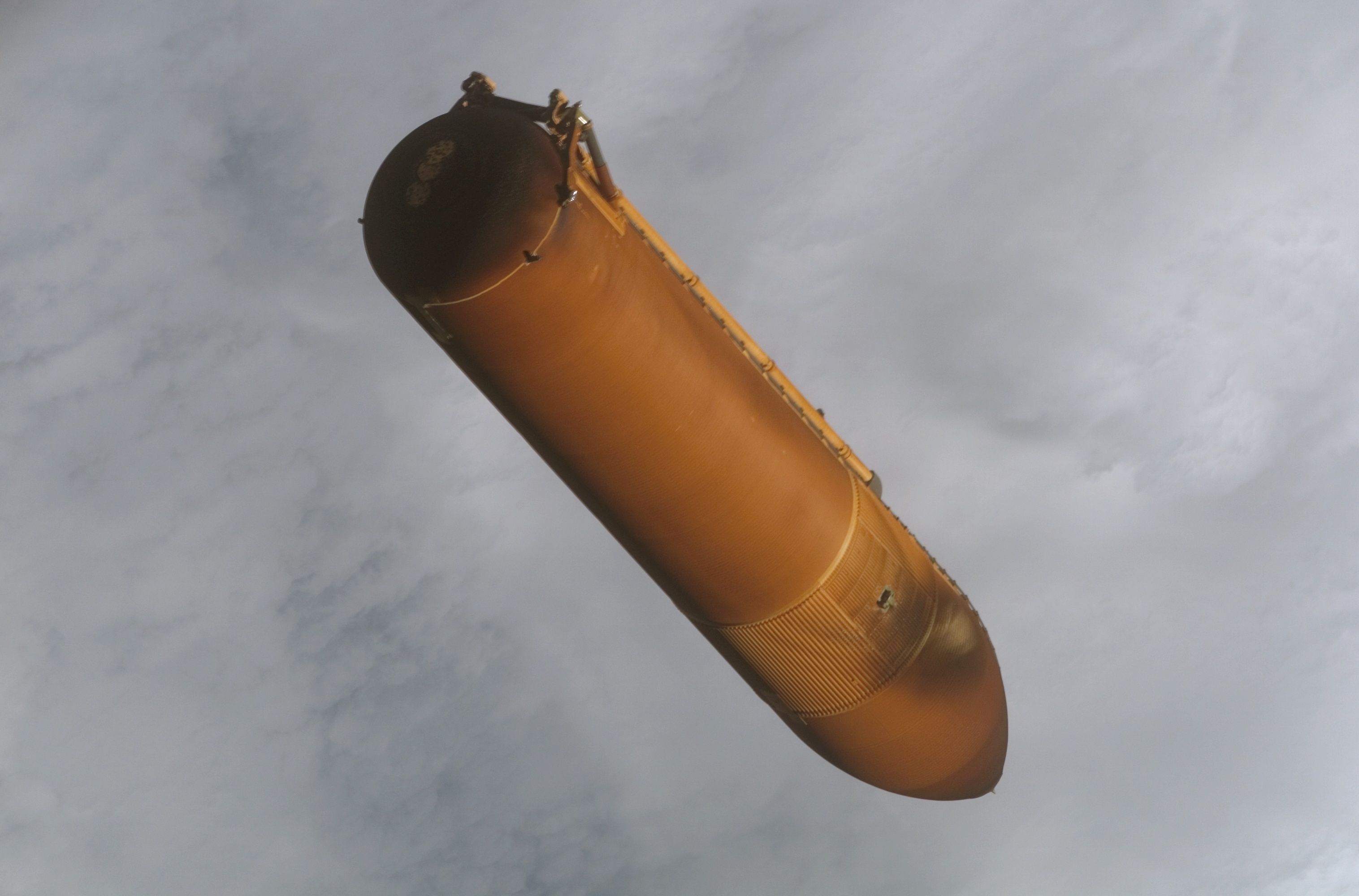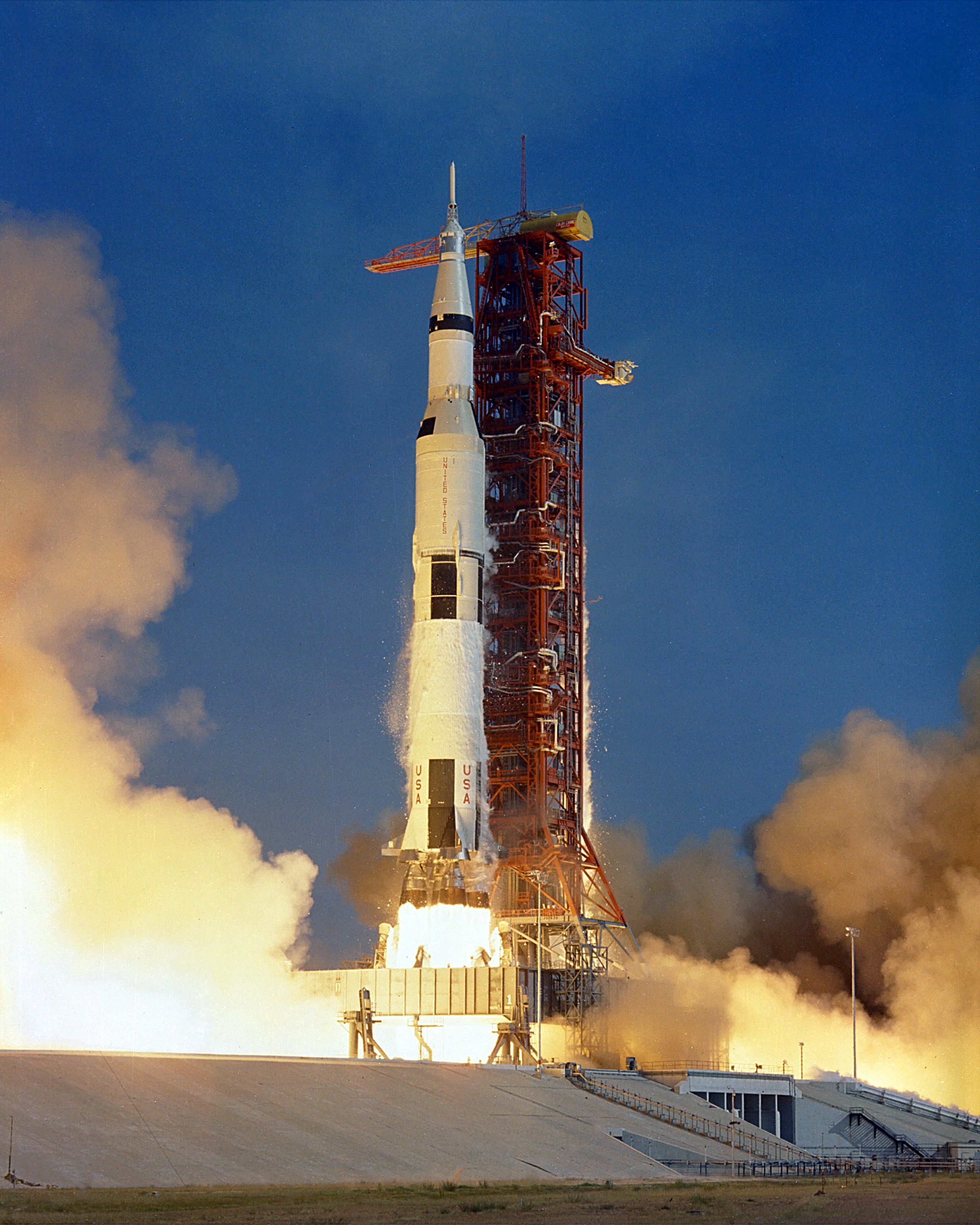|
Vehicle Assembly Building
The Vehicle Assembly Building (originally the Vertical Assembly Building), or VAB, is a large building at NASA's Kennedy Space Center (KSC), designed to assemble large pre-manufactured space vehicle components, such as the massive Saturn V and the Space Shuttle, and stack them vertically onto one of three mobile launcher platforms used by NASA. As of March 2022, the first Space Launch System (SLS) rocket was assembled inside in preparation for the Artemis 1 mission, which launched on November 16, 2022. At , it is the eighth-largest building in the world by volume as of 2022. The building is at Launch Complex 39 at KSC, south of Jacksonville, north of Miami, and due east of Orlando, on Merritt Island on the Atlantic coast of Florida. The VAB is the largest single-story building in the world, was the tallest building () in Florida until 1974, and is the tallest building in the United States outside an urban area. History The VAB, which was completed in 1966, was originally bui ... [...More Info...] [...Related Items...] OR: [Wikipedia] [Google] [Baidu] |
Artemis 1
Artemis 1, officially Artemis I and formerly Exploration Mission-1 (EM-1), was an uncrewed Moon-orbiting mission. As the first major spaceflight of NASA's Artemis program, Artemis 1 marked the return of the agency to lunar exploration originally begun as the Apollo program decades earlier. It was the first integrated flight test of the Orion spacecraft and Space Launch System (SLS) rocket. Its main objective was to test the Orion spacecraft, especially its heat shield, in preparation for subsequent Artemis missions. These missions seek to reestablish a human presence on the Moon and demonstrate technologies and business approaches needed for future scientific studies, including exploration of Mars. The Orion spacecraft for Artemis 1 was stacked on October 20, 2021, marking the first time a super-heavy-lift vehicle has been stacked inside NASA's Vehicle Assembly Building (VAB) since the final Saturn V in 1973. On August 17, 2022, the fully stacked vehicle was rolled out for ... [...More Info...] [...Related Items...] OR: [Wikipedia] [Google] [Baidu] |
Merritt Island, Florida
Merritt Island is a peninsula, commonly referred to as an island, in Brevard County, Florida, United States, located on the eastern Floridian coast, along the Atlantic Ocean. It is also the name of an unincorporated town in the central and southern parts of the island and a census-designated place (CDP). The population was 34,518 at th2020 census It is part of the Palm Bay – Melbourne – Titusville, Florida Metropolitan Statistical Area. NASA's John F. Kennedy Space Center is located on Merritt Island to the north of the town, and Merritt Island National Wildlife Refuge is located north of the space center. The central part of Merritt Island, previously known as Merritt City, is home to the majority of the population and includes the local high school, library, and shopping district. The southern area is heavily residential, with centralized light commercial and light industrial areas. History Etymology Merritt Island owes its name to the King of Spain. The ... [...More Info...] [...Related Items...] OR: [Wikipedia] [Google] [Baidu] |
American Society Of Civil Engineers
American(s) may refer to: * American, something of, from, or related to the United States of America, commonly known as the "United States" or "America" ** Americans, citizens and nationals of the United States of America ** American ancestry, people who self-identify their ancestry as "American" ** American English, the set of varieties of the English language native to the United States ** Native Americans in the United States, indigenous peoples of the United States * American, something of, from, or related to the Americas, also known as "America" ** Indigenous peoples of the Americas * American (word), for analysis and history of the meanings in various contexts Organizations * American Airlines, U.S.-based airline headquartered in Fort Worth, Texas * American Athletic Conference, an American college athletic conference * American Recordings (record label), a record label previously known as Def American * American University, in Washington, D.C. Sports teams Soccer ... [...More Info...] [...Related Items...] OR: [Wikipedia] [Google] [Baidu] |
National Historic Civil Engineering Landmark
__NOTOC__ The following is a list of Historic Civil Engineering Landmarks as designated by the American Society of Civil Engineers since it began the program in 1964. The designation is granted to projects, structures, and sites in the United States (National Historic Civil Engineering Landmarks) and the rest of the world (International Historic Civil Engineering Landmarks). As of 2019, there are over 280 landmarks that have been approved by the ASCE Board of Direction. Sections or chapters of the American Society of Civil Engineers may also designate state or local landmarks within their areas; those landmarks are not listed here. See also *[...More Info...] [...Related Items...] OR: [Wikipedia] [Google] [Baidu] |
Kennedy Space Center Launch Complex 39B
Launch Complex 39B (LC-39B) is the second of Launch Complex 39's three launch pads, located at NASA's Kennedy Space Center in Merritt Island, Florida. The pad, along with Launch Complex 39A, was first designed for the Saturn V launch vehicle, which at the time was the United States' most powerful rocket. Typically used to launch NASA's crewed spaceflight missions since the late 1960s, the pad is currently configured for use by the agency's Space Launch System rocket, a Shuttle-derived launch vehicle which is currently used in the Artemis program and subsequent Moon to Mars campaigns. The pad had also been leased by NASA to aerospace company Northrop Grumman, for use as a launch site for their Shuttle-derived OmegA launch vehicle, for National Security Space Launch flights and commercial launches, before the OmegA program was cancelled. History Apollo program In 1961, President Kennedy proposed to Congress the goal of landing a man on the Moon by the end of the decade. Congr ... [...More Info...] [...Related Items...] OR: [Wikipedia] [Google] [Baidu] |
Kennedy Space Center Launch Complex 39A
Launch Complex 39A (LC-39A) is the first of Launch Complex 39's three launch pads, located at NASA's Kennedy Space Center in Merritt Island, Florida. The pad, along with Launch Complex 39B, were first designed for the Saturn V launch vehicle. Typically used to launch NASA's crewed spaceflight missions since the late 1960s, the pad was leased by SpaceX and has been modified to support their launch vehicles. History Apollo program In 1961, President Kennedy proposed to Congress the goal of landing a man on the Moon by the end of the decade. Congressional approval led to the launch of the Apollo program, which required a massive expansion of NASA operations, including an expansion of launch operations from the Cape to adjacent Merritt Island to the north and west. First, Launch Complex 39C, Launch Complex 39A was designed to handle launches of the Saturn V rocket, the largest and most powerful launch vehicle, which would propel Apollo spacecraft to the Moon. The first launch ... [...More Info...] [...Related Items...] OR: [Wikipedia] [Google] [Baidu] |
Crawler-transporter
The crawler-transporters, formally known as the Missile Crawler Transporter Facilities, are a pair of tracked vehicles used to transport spacecraft from NASA's Vehicle Assembly Building (VAB) along the Crawlerway to Launch Complex 39. They were originally used to transport the Saturn IB and Saturn V rockets during the Apollo, Skylab and Apollo–Soyuz programs. They were then used to transport Space Shuttles from 1981 to 2011. The crawler-transporters carry vehicles on the mobile launcher platforms used by NASA, and after each launch return to the pad to take the platform back to the VAB. The two crawler-transporters were designed and built by Marion Power Shovel Company using some components designed and built by Rockwell International at a cost of ( in 2022) each. Upon its construction, the crawler-transporter became the largest self-powered land vehicle in the world. While other vehicles such as bucket-wheel excavators like Bagger 288, dragline excavators like Big Mus ... [...More Info...] [...Related Items...] OR: [Wikipedia] [Google] [Baidu] |
Space Shuttle Solid Rocket Booster
The Space Shuttle Solid Rocket Booster (SRB) was the first solid-propellant rocket to be used for primary propulsion on a vehicle used for human spaceflight. A pair of these provided 85% of the Space Shuttle's thrust at liftoff and for the first two minutes of ascent. After burnout, they were jettisoned and parachuted into the Atlantic Ocean where they were recoverable booster, recovered, examined, refurbished, and reusable launch system, reused. The Space Shuttle SRBs were the most powerful solid rocket motors to ever launch humans. The Space Launch System (SLS) SRBs, adapted from the shuttle, surpassed it as the most powerful solid rocket motors ever flown, after the launch of the Artemis-1 mission. Each Space Shuttle SRB provided a maximum thrust, roughly double the most powerful single-combustion chamber liquid-propellant rocket engine ever flown, the Rocketdyne F-1. With a combined mass of about , they comprised over half the mass of the Shuttle stack at liftoff. The motor ... [...More Info...] [...Related Items...] OR: [Wikipedia] [Google] [Baidu] |
Space Shuttle External Tank
The Space Shuttle external tank (ET) was the component of the Space Shuttle launch vehicle that contained the liquid hydrogen fuel and liquid oxygen oxidizer. During lift-off and ascent it supplied the fuel and oxidizer under pressure to the three RS-25 main engines in the orbiter. The ET was jettisoned just over 10 seconds after main engine cut-off (MECO) and it re-entered the Earth's atmosphere. Unlike the Solid Rocket Boosters, external tanks were not re-used. They broke up before impact in the Indian Ocean (or Pacific Ocean in the case of direct-insertion launch trajectories), away from shipping lanes and were not recovered. Overview The ET was the largest element of the Space Shuttle, and when loaded, it was also the heaviest. It consisted of three major components: * the forward liquid oxygen (LOX) tank * an unpressurized intertank that contains most of the electrical components * the aft liquid hydrogen (LH2) tank; this was the largest part, but it was relativel ... [...More Info...] [...Related Items...] OR: [Wikipedia] [Google] [Baidu] |
Space Shuttle Orbiter
The Space Shuttle orbiter is the spaceplane component of the Space Shuttle, a partially reusable orbital spacecraft system that was part of the discontinued Space Shuttle program. Operated from 1977 to 2011 by NASA, the U.S. space agency, this vehicle could carry astronauts and payloads into low Earth orbit, perform in-space operations, then re-enter the atmosphere and land as a glider, returning its crew and any on-board payload to the Earth. Six orbiters were built for flight: '' Enterprise'', ''Columbia'', '' Challenger'', '' Discovery'', ''Atlantis'', and ''Endeavour''. All were built in Palmdale, California, by the Pittsburgh, Pennsylvania-based Rockwell International company. The first orbiter, ''Enterprise'', made its maiden flight in 1977. An unpowered glider, it was carried by a modified Boeing 747 airliner called the Shuttle Carrier Aircraft and released for a series of atmospheric test flights and landings. ''Enterprise'' was partially disassembled and retired ... [...More Info...] [...Related Items...] OR: [Wikipedia] [Google] [Baidu] |
Space Vehicle
A space vehicle is the combination of a spacecraft and its launch vehicle which carries it into space. The earliest space vehicles were expendable launch systems, using a single or multistage rocket to carry a relatively small spacecraft in proportion to the total vehicle size and mass. An early exception to this, the Space Shuttle, consisted of a reusable orbital vehicle carrying crew and payload, supported by an expendable external propellant tank and two reusable solid-fuel booster rockets. Reusable launch systems are currently being developed by private industry. Early spacecraft or space vehicles were sometimes hyped as " spaceships", a term which comes from science fiction to designate a hypothetical vehicle which travels beyond low Earth orbit and is 100% reusable, needing only to be refueled like an airplane. History In the 1865 Jules Verne novel '' From the Earth to the Moon'', successful attempts are made to launch three people in a projectile with the goal of a ... [...More Info...] [...Related Items...] OR: [Wikipedia] [Google] [Baidu] |









